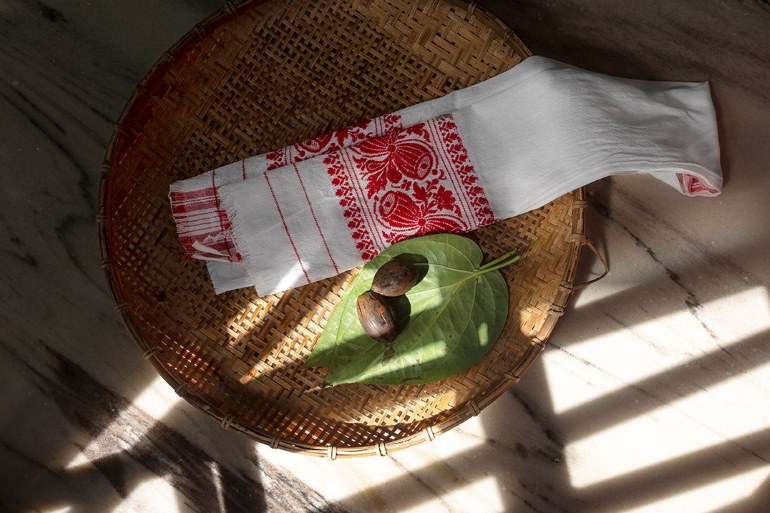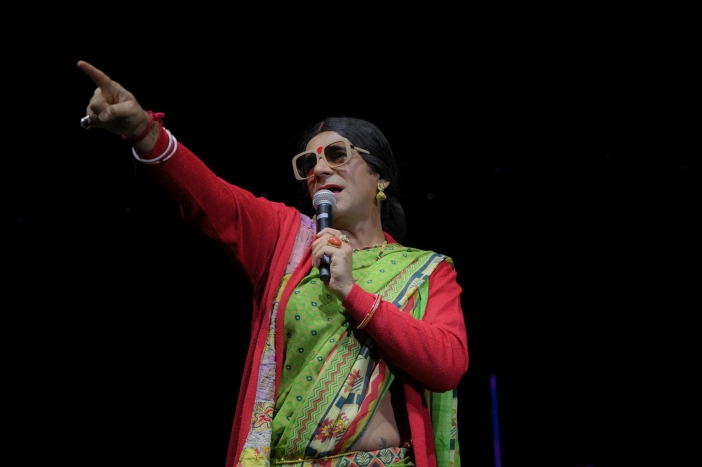Dastkari Haat Samiti presents ‘GAMCHHA: From the Ordinary to the Extraordinary’, a multimedia exhibition at the The National Crafts Museum & Hastkala Academy in Delhi. Running from 1st to 10th March 2025, the exhibition documents gamchhas from 14 states across India, and Southeast Asian countries, highlighting their regional diversity, unique craftsmanship, cultural symbolism and often-overlooked presence in today’s Indian society. It also includes art installations, design interventions and live demonstrations, exploring the fabric’s many uses.
Often overlooked amidst India’s celebrated handloom traditions, the gamchha—sometimes spelt Gamcha, Gamucha, or Gamusa—represents millions of Indians. This simple, coarse fabric, typically 70” in length and 35” in width, traces its origin to the working-class communities’ need for a practical, multipurpose cloth. Over time, its versatility has allowed it to rise beyond its humble beginnings. The unassuming fabric becomes a fishing net, a vegetable bag and makeshift belt in rural Bengal. In Bihar it is an offering to the river goddess, while in Assam the pristine white gamosa is a symbol of respect. It is no surprise this everyday garment has been embraced publicly by Prime Minister Narendra Modi, while filmmaker Anurag Kashyap once paired it with a Dior suit at Cannes.
President of Dastkari Haat Samiti, Jaya Jaitly’s own engagement with the cloth began in 2015, when they commissioned women weavers in Phulia, West Bengal to create 100 gamchha saris. In a world that values exclusivity, this common man’s cloth embodies the beauty of simplicity. “It is everywhere, yet no one notices it,” she remarks. In the streets, in the homes; on the head, in the hand—this ubiquitous Gamchha, has been a silent companion. It has wiped the sweat of labourers and farmers, balanced pots on heads, wrapped vegetables, served as a towel, as a kerchief, and even metaphorically held hunger at bay. A leitmotif of survival, dignity, and resilience, it is an object of unexpected beauty that often goes unnoticed in daily life.
This exhibition, curated and designed by Suparana Bhalla of Abaxial Design Pvt Ltd seeks to address the neglect of the gamchha. Her innovative display of latticed bamboo and steel captures the twists and turns of the fabric and its inherent structure. “It emulates the liberation and oppression as symbolised by the gamchha,” says Suparna Bhalla. Architect and origami artist Ankon Mitra has used his distinct approach, Oritecture, to create two spatial installations that reimagine the gamchha from a simple 2D textile into multidimensional art. His suspended installation elevates the ubiquitous red and white chequered Gamchha from a central to almost sacred object in a Bengali household, while another—drawing an analogy from the countryside trees—explores the fabric’s profound yet unnoticed presence in Indian culture. The project also includes live demonstrations by craftspeople and entrepreneurs, displaying gamchha-inspired creations such as saris, fashion apparel, accessories, lifestyle products, and memorabilia.
More than a display—this exhibition is a crucial intervention at a time when traditional textiles face extinction from mass production and cheap imports. “It would be a shame indeed for both the Indian weaver and wearer to lose the Gamchha to mass industrial production or cheap imports.” laments Jaya Jaitly. Often overlooked in favor of more celebrated textiles, the modest fabric is a quiet yet profound testament to India’s resourcefulness. “Just as Charles and Ray Eames elevated the everyday Lota” adds Mitra, “we hope to bring the Gamchha into focus as a symbol of Indian design thinking at its grassroot.” “Neither an exotic Kanjeevaram, nor a feted Banarasi silk, the Gamchha, a fifty rupees worth of ordinary fabric that we see, yet unsee, will finally find the dignity it deserves,” exclaims Jaya Jaitly.
- What: GAMCHHA: From the Ordinary to the Extraordinary
- Where: The National Crafts Museum and Hastkala Academy, Bhairon Marg,
- Pragati Maidan, New Delhi, 110001
- When: 1st – 10th March, 2025Timing: 11:00 am to 8:00 pm





